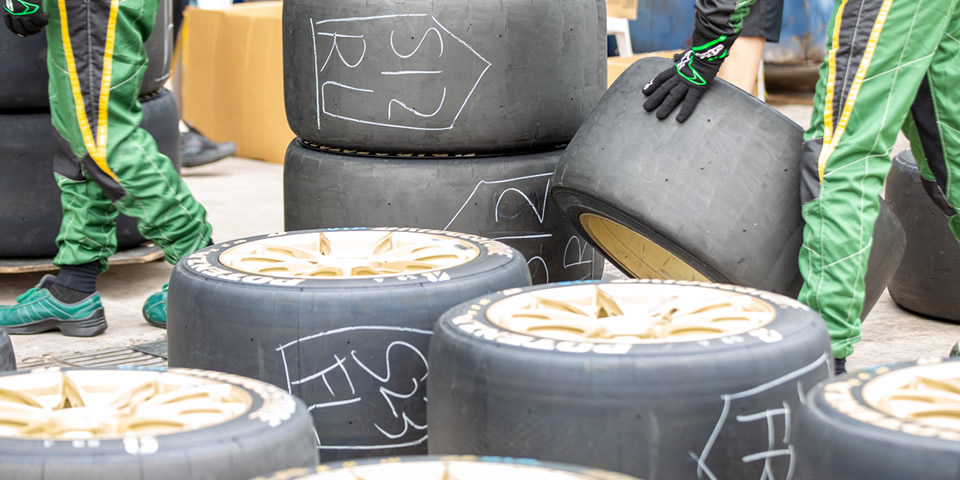Why are F1 Tires Shiny?
The shiny appearance of F1 tires is not just for show, but rather an essential component in maximizing performance on the race track!

In the high-octane world of Formula 1 racing, every little detail matters. From the aerodynamics of the car to the expertise of the driver, teams leave no stone unturned in their quest for victory. One often overlooked aspect that plays a crucial role in enhancing performance is the shine of the tires.
Have you ever wondered why F1 tires appear so vibrant and shiny during races? It’s not just for aesthetics; there’s actually a scientific reason behind it. The shiny appearance of the tires is achieved through the application of tire shine, a specially formulated product that adds a glossy finish.
The importance of tire shine in Formula 1 is two-fold. Firstly, it serves as a protective layer, preventing debris, dirt, and rubber residue from accumulating on the tires. As the cars race around the track at incredibly high speeds, the tires come into contact with various elements that can hinder traction and performance. By keeping the tires clean and free from buildup, tire shine ensures optimal grip between the tire and the track surface, allowing the drivers to push the limits of their speed and maneuverability.
The Science Behind F1 Tires Shine
Tire shine is not just a magic potion that instantly adds shine to F1 tires; it is a meticulously engineered product with a complex chemical composition. Understanding the science behind tire shine can help us appreciate its role in keeping F1 tires glossy and maximizing performance on the track.
The primary components of tire shine are solvents, polymers, and silicones. Solvents are responsible for breaking down any existing dirt or residue on the tires, allowing them to be easily removed. Polymers, on the other hand, have the ability to bond with the rubber surface of the tires, creating a protective coating that enhances shine and durability. Silicones, commonly used in tire shine formulations, provide water resistance and further increase the glossy appearance of the tires. The process of creating tire shine involves precise blending of these ingredients.
The solvents, such as petroleum distillates or alcohols, are mixed with the polymers and silicones in carefully controlled ratios. This ensures that the tire shine not only cleans the tires but also promotes adhesion and adds a long-lasting shine. When the tire shine is applied to F1 tires, the solvents quickly evaporate, leaving behind a thin layer of polymers and silicones that form a protective coating.
This coating not only enhances the aesthetic appeal of the tires but also acts as a barrier against dirt, debris, and moisture. It helps to prevent oxidation and fading, keeping the tires glossy even after multiple laps on the demanding racetrack. The tire shine also provides a level of UV protection, guarding against the damaging effects of sunlight.
So, the next time you see those shiny F1 tires zooming down the track, remember that it’s not just for show – it’s the result of a carefully crafted formula that combines science and technology to optimize performance and visual impact.

Benefits of Shiny Tires in F1
Having shiny tires in Formula 1 is not just about aesthetics; it brings a multitude of benefits that can greatly impact performance on the track. Let’s delve into the advantages of having shiny tires and why they are so coveted in the world of F1 racing.
First and foremost, one of the key advantages of shiny tires is improved traction. As F1 cars hurtle around corners and power down straightaways, having maximum grip is paramount. Shiny tires provide better adherence to the track surface, allowing drivers to brake later, accelerate earlier, and maintain control through high-speed turns. This enhanced traction is crucial when it comes to achieving faster lap times and gaining a competitive edge.
Furthermore, shiny tires contribute to improved aerodynamics. In F1, every fraction of a second counts, and reducing air resistance is paramount to achieving higher speeds. The smooth, glossy surface of shiny tires helps air flow more efficiently around the tire, minimizing drag and increasing overall aerodynamic performance. This allows the car to slice through the air with less resistance, resulting in higher top speeds and better overall handling.
In addition to the performance benefits, shiny tires also have a visual appeal that cannot be underestimated. In the fast-paced world of Formula 1, perception plays a significant role. Shiny tires add a touch of glamour to the cars, creating a visually captivating spectacle for fans and sponsors. As the cars race down the track, the gleaming tires not only catch the eye but also add to the overall aesthetic appeal of the sport, enhancing the experience for both spectators and television viewers alike.
In conclusion, the advantages of having shiny tires in Formula 1 are numerous. From improved traction to enhanced aerodynamics and visual appeal, shiny tires are a vital component that contribute to the overall performance and spectacle of the race. Next time you find yourself marveling at the gleaming tires of an F1 car, remember that there is more to their shine than meets the eye – it’s an essential part of achieving success in the world’s most prestigious racing championship.
How Teams Maintain Tire Shine in F1
Maintaining the shine of F1 tires throughout a race is no easy feat. As the cars navigate hairpin turns, face unpredictable weather conditions, and accumulate debris from the track, it becomes crucial for teams to have effective techniques in place to ensure their tires stay shiny and perform optimally. Let’s take a closer look at some of the tips and methods employed by F1 teams to keep their tires glistening throughout the demanding race sessions.
One of the key techniques used by teams is regular tire cleaning. Throughout the race weekend, mechanics diligently clean the tires to remove any dirt, rubber residue, or debris that may have accumulated. This is typically done using a combination of specially formulated cleaning solutions, brushes, and cloths. The cleaning process not only restores the shine of the tires but also helps maintain optimal traction and grip.
In addition to routine cleaning, F1 teams carefully select tire shine products that offer long-lasting effects. These products are specifically designed for the demanding conditions of high-speed racing and are formulated to provide maximum shine and protection. Teams often opt for silicone-based tire shine products that create a durable glossy finish on the tires. These products not only enhance the visual appeal but also offer added benefits such as water resistance and protection against UV damage.
Another technique employed by F1 teams is tire warming. Before a race or during pit stops, teams use specialized tire warmers to heat the tires to the ideal operating temperature. This has a two-fold effect. Firstly, it ensures that the tires are at the optimal temperature to provide maximum grip and performance. Secondly, the heat helps the tire shine product penetrate the rubber surface more effectively, enhancing and prolonging the shine.
Moreover, teams closely monitor track conditions to adjust their tire care strategies accordingly. If the track is particularly dirty or debris-laden, teams may employ additional cleaning methods, such as using compressed air to blow off loose debris or employing tire scrubbing machines to remove stubborn residue.
In conclusion, F1 teams leave no stone unturned in their pursuit of maintaining shiny tires throughout a race. Through diligent cleaning, careful product selection, tire warming, and tailored maintenance strategies, teams ensure that their tires not only perform at their best but also maintain a visually striking appearance throughout the demanding race sessions. By incorporating these techniques, teams can maximize traction, optimize performance, and make a lasting impression on the track.











